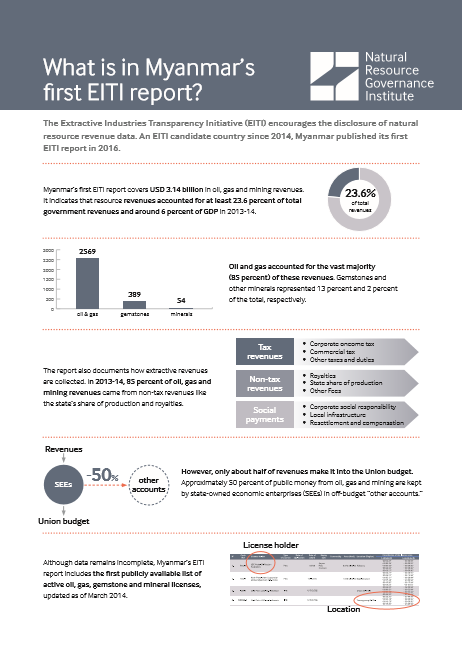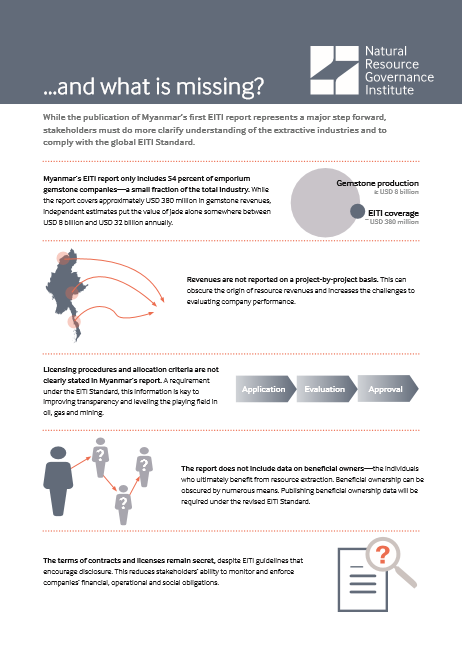
Parsing First Myanmar EITI Report
This article was originally featured as an op-ed in the Myanmar Times on 10 June 2016.
Who profits from the oil, gas and mining industries? And how do citizens benefit from resource extraction? Myanmar has made significant progress toward addressing these questions since joining the Extractive Industries Transparency Initiative (EITI), a global effort to make information from the natural resource sector publicly available. (For more information, see NRGI’s guide on the EITI Standard.) The initiative is anchored in the belief that more complete information can promote accountable management of countries’ natural resources.
Myanmar’s recently released first EITI report, covering the 2013-14 fiscal year, includes previously undisclosed data on resource production, revenue flows, licenses and company ownership.
The information has shed light on Myanmar’s historically opaque extractive sector and helped to build a case for further transparency in areas where knowledge remains lacking. But even the most intrepid reader will balk at the prospect of wading through a 144-page technical report and its annexes. With such a flood of data, most Myanmar citizens cannot utilize these findings or understand their stake in the disclosure process.
In brief, here’s what the average person needs to know:
- Myanmar’s first EITI report covers just over MMK 3 trillion (approximately USD 3.1 billion) in extractive industry revenues. Per person, this means that the government collected approximately MMK 58,500 from oil, gas and mining companies in 2013-14.That’s equivalent to roughly three weeks’ worth of salary for a Myanmar citizen working at minimum wage.
- The money collected from natural resources can benefit the public by funding needed services like health and education. But less than half of the money received from oil, gas and mining companies made it into the Union budget. Since 2012, the state-owned economic enterprises that collect many natural resource revenues have been allowed to keep some revenues in separate accounts with limited oversight. How the enterprises manage these funds is not disclosed to Myanmar citizens or to their elected representatives. As a result, the government only received MMK 28,500 per citizen (MMK 30,000 less than the anticipated amount) in 2013-14.
-
Myanmar’s EITI report also shows that industries’ contributions to the national budget have been highly unequal. Of the total MMK 58,500 per person in extractive revenues collected by Myanmar’s government, roughly MMK 50,000 (or 85 percent) came from oil and natural gas. Gems and precious stones contributed approximately MMK 7500 per person while other minerals only generated MMK 1,000 per person in revenues.
The production value of gemstones and minerals is not as insignificant as these numbers suggest. The low value is partly the result of the EITI report’s limited scope, which only covers 53 percent of gemstone companies selling at the annual emporium. It also reflects widespread illegal activity in the mining sector, which prevents the government from collecting taxes.
There is evidence to suggest that mining revenues, especially from gemstones, could be even greater than those from oil and gas if taxes were effectively levied. China reported importing USD 11.8 billion worth of precious stones from Myanmar in 2014. This trade alone should have generated more than MMK 67,500 per person in additional revenues if it were subjected to Myanmar’s 30 percent commercial tax on gemstone exports. Even without taking into account other important forms of taxation such as the corporate income tax, that sum is greater than reported oil, gas and mining revenues combined. -
For the first time, Myanmar’s EITI report allows stakeholders to know which companies hold many oil, gas and mining licenses. Data available via the EITI website includes the licensed company’s name, its legal owners, the type of license, the commodity being extracted, the licensed area, and the date of award and expiration.
On the other hand, the terms of the licenses and contracts have not been disclosed, meaning that the arrangements and obligations under which oil, gas and mining companies operate remain secret. Moreover, while legal owners are listed in the EITI report, it is often the case that the persons who ultimately profit from natural resource companies remain hidden.
One example is Myanmar Imperial Jade. The company is listed as the holder of 428 out of 1,258 (or approximately 34 percent) gemstone licenses covered by the EITI report. Myanmar Imperial Jade is legally owned by United Myanmar Economic Holdings Limited (UMEHL), a military enterprise. However, the identities of Myanmar Imperial Jade’s “beneficial owners”—the individuals who ultimately benefit from the company and its gemstone activities—have not been made public. In other cases, the person listed as the legal owner of a company may serve as an intermediary (proxy) for a spouse, friend or relative who ultimately exercises control and benefits from the entity.
Although areas for improvement remain, Myanmar’s first EITI report allows stakeholders unprecedented insight into the natural resource sector. EITI data can support advocacy for reformed and responsible governance of oil, gas and mining – such as improved accountability for state-owned economic enterprise revenues, greater oversight of the gemstone sector, or stronger rules regarding disclosure of contracts and beneficial owners. While working to address remaining knowledge gaps in its next EITI report, Myanmar’s new government should also focus on putting this powerful information into the hands of stakeholders and citizens.
Paul Shortell is a visiting fellow with the Natural Resource Governance Institute (NRGI) in Yangon.

